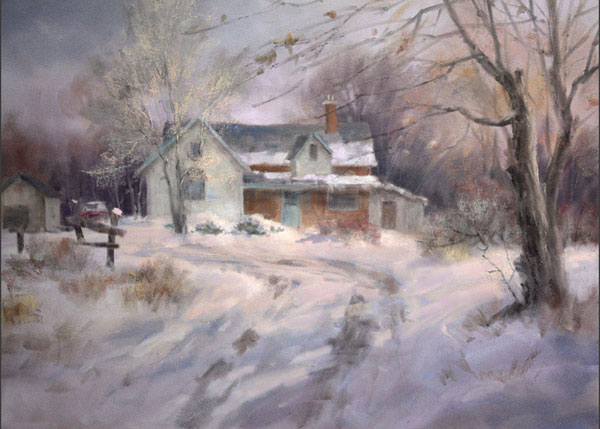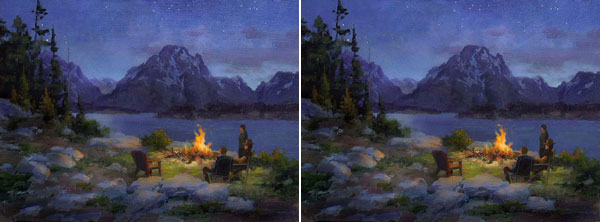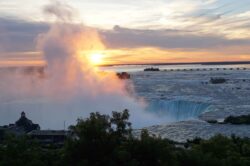Painting for Beginners: Making a Final Assessment of Your Art

During my painting classes I frequently get this question: “How do you know when a painting is finished?” All artists are faced with this dilemma. Shall I add this or remove that? On and on it goes. I like this quote from Leonardo Da Vinci: “Art is never finished, only abandoned.” Even though that says quite a bit, it doesn’t say it all. I tell my students to continue working on their painting until they have removed:
• All that doesn’t contribute to the composition; that which they added for the sheer purpose of documenting
• Anything the viewer would not miss unless he saw the photo reference
Painting for Beginners: Justify Your Elements
Ask yourself why you depicted an object in the first place. If you answer by saying it was in the reference photo or in the plein air scene, it may become painting clutter. There needs to be a compositional justification for it. If there is, chances are it will fit into your artwork. If the answer to the “why” does not stand up to scrutiny, I would shred it. If you err on the side of simplicity and leave it out, in most cases it will prove to be the right decision, especially with small paintings.

How to Paint for Beginners: Questions to Ask Yourself
Ask yourself these questions before signing your painting and declaring it ready to be framed.
1) Can I still make elements recede more to create depth? Remember you always have the option to scumble over areas to add more atmospheric perspective. Glazing yellows and oranges can add warmth; with violet you can tone down saturated colors as well.
2) Did I institute a visual path?
3) Am I moving the viewer’s eye too quickly?
4) Am I cloning any shapes? Remember they don’t have to be precise clones. Similar shapes need to be considerably different even when viewing from 15 feet away.
5) Can I simplify the painting more?
6) Are my lines boring? Can I tweak them for more visual melody?
7) Will the composition improve if I crop it? Even if it is an oil painting, you can cut the ideal section from the canvas and paste it on a wood panel.
8) Can I implement the pointers at the top of this blog?
9) How is the distribution of these masses, sky, vertical plane and horizontal plane? Am I dedicating too many square inches to any of them or are they competing for attention?
10) Does my painting have two dramatically different sides or am I creating two competitive sides?
11) Can I enhance the mood by adding fog or changing the time of day to show a late evening or even a nocturne scene?
12) Am I unnecessarily resorting to darker values?
13) Can I still soften edges in certain areas?
14) Did I render trees, bushes and rocks that show a three-dimensional volume?
15) Did I variegate the colors?

An Final Assessment Approach
1) Open your painting image in a graphics program and flip it horizontally. You can use a mirror also. This will give you a fresh perspective. You’d be surprised how different it looks and how discrepancies stand out.
2) Flip it vertically to get an upside version. You will only see shapes that don’t make too much sense. This will allow you to determine if they are designed properly.
3) Take into account that small paintings seen from across the room are reduced. Shapes that are nearly symmetrical will become too obvious. Implied clones will stand out. Also, blurred edges seem sharper when viewed from several yards away.
4) Finally, convert your artwork to a gray scale to see how well your values are working. The black and white version should be quite competitive in beauty compared to the colored rendering.
If, after all these suggestions, your painting looks good, frame it!
“Landscape Painting Essentials” and other video courses are available at NorthLightShop.com. North Light has also just released a new eBook written by Johannes titled Landscape Painting Essentials. Join his online art classes at http://improvemypaintings.com.
 Artists Network Membership - 1 Year
Artists Network Membership - 1 Year  Breakthrough Paint Along: Where Mixed Media Combine Together
Breakthrough Paint Along: Where Mixed Media Combine Together  Paint Along 127: Paint the Motion of the Sea
Paint Along 127: Paint the Motion of the Sea  Breakthrough Paint Along: The Big Value of Miniature Landscapes
Breakthrough Paint Along: The Big Value of Miniature Landscapes  Portrait Painting: Rembrandt's Techniques Video Download
Portrait Painting: Rembrandt's Techniques Video Download  Figure Drawing Tips with Brent Eviston Video Download
Figure Drawing Tips with Brent Eviston Video Download  Southwest Art August/September 2025 Digital Edition
Southwest Art August/September 2025 Digital Edition  Artists Magazine July/August 2025 Digital Edition
Artists Magazine July/August 2025 Digital Edition  Pastel Journal Summer 2025 Digital Edition
Pastel Journal Summer 2025 Digital Edition  Artists Magazine March/April 2025 Digital Edition
Artists Magazine March/April 2025 Digital Edition  Artists Magazine January/February 2025 Digital Edition
Artists Magazine January/February 2025 Digital Edition  Best of Watercolor: Winners of the Splash 26 Competition Print Edition
Best of Watercolor: Winners of the Splash 26 Competition Print Edition  Southwest Art June/July 2025 Print Edition
Southwest Art June/July 2025 Print Edition  Artists Magazine May/June 2025 Print Edition
Artists Magazine May/June 2025 Print Edition  Southwest Art 2021 Digital Collection × 1
Southwest Art 2021 Digital Collection × 1  Watercolor Artist 2020 Digital Collection × 1
Watercolor Artist 2020 Digital Collection × 1  Watercolor Artist 2019 Annual Digital Collection × 1
Watercolor Artist 2019 Annual Digital Collection × 1  Watercolor Mega Magazine Collection × 1
Watercolor Mega Magazine Collection × 1  Pastel for Beginners Workshop
Pastel for Beginners Workshop  Composition & Design for Landscape Painting Video Workbook
Composition & Design for Landscape Painting Video Workbook  Drawing Mastery: Shading Course
Drawing Mastery: Shading Course  Alla Prima Bootcamp: 4 Weeks to Confident Painting Course
Alla Prima Bootcamp: 4 Weeks to Confident Painting Course  Eight Greats: The Pastel Journal's 10th Anniversary Artist Interview Series Digital Download
Eight Greats: The Pastel Journal's 10th Anniversary Artist Interview Series Digital Download  Secrets of Hyperrealist Watercolor Course
Secrets of Hyperrealist Watercolor Course  Acrylic Artist Summer 2017 Digital Edition
Acrylic Artist Summer 2017 Digital Edition  Exploring Acrylic: Abstract Art in Action Video Download
Exploring Acrylic: Abstract Art in Action Video Download  WetCanvas Live! Paint Stunning Landscapes from Photos: Lesson 23 & 24 Video Download
WetCanvas Live! Paint Stunning Landscapes from Photos: Lesson 23 & 24 Video Download  WetCanvas Live! Paint Stunning Landscapes from Photos: Lesson 9 & 10 Video Download
WetCanvas Live! Paint Stunning Landscapes from Photos: Lesson 9 & 10 Video Download  The Whimsical Face with Jane Davenport Video Download
The Whimsical Face with Jane Davenport Video Download  Mixed-Media Faces Made Easy Video Download
Mixed-Media Faces Made Easy Video Download  What It Takes to Teach Video Download
What It Takes to Teach Video Download  On the hunt for found objects: How to Create New and Eclectic Molds Video Download
On the hunt for found objects: How to Create New and Eclectic Molds Video Download  Urban Sketching: Drawing People in Places Video Workbook
Urban Sketching: Drawing People in Places Video Workbook  Graffiti Grunge Art by Jodi Ohl Video Workbook
Graffiti Grunge Art by Jodi Ohl Video Workbook  Portraits: From Good to Great Video Download
Portraits: From Good to Great Video Download  Low-Tech Metal Apps: Wire, Foil, Mesh, & Screen Video Download
Low-Tech Metal Apps: Wire, Foil, Mesh, & Screen Video Download  Paint Along 126: Simplify Your Landscapes with a Limited Palette
Paint Along 126: Simplify Your Landscapes with a Limited Palette  Experimental Pastel Techniques with Dawn Emerson Video Download
Experimental Pastel Techniques with Dawn Emerson Video Download  Painting Patterned Trees Video Download
Painting Patterned Trees Video Download  Paint Along 125: Paint the Charming Towns of Italy
Paint Along 125: Paint the Charming Towns of Italy  Essentials of Painting Still Lifes
Essentials of Painting Still Lifes  7 Days to a Steady Journal Practice Video Download
7 Days to a Steady Journal Practice Video Download 





Have a technical question?
Contact UsJoin the Conversation!